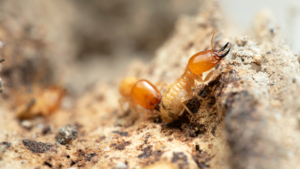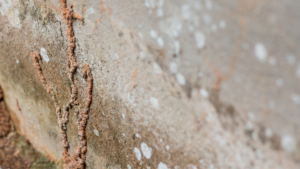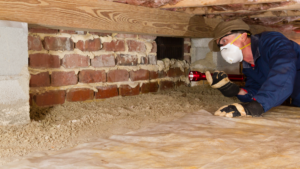
Why Trenching Works: Protecting Your Home from Subterranean Termites
Subterranean termites can cause serious damage to your home if left unchecked. These pests are experts at hiding and can chew through wood, flooring, and even wallpaper undetected. Homeowners need effective ways to protect their homes from these destructive insects, and trenching is a proven method to do just that.
Trenching involves digging a trench around your home’s foundation and applying a termiticide to create a protective barrier. This barrier keeps termites from reaching your home and helps to eliminate any colonies that might be nearby. Unlike other methods that only address termites already inside your home, trenching provides a long-lasting solution that stops termites before they can cause damage.
With that in mind, we’re here to help you explore what makes the trenching method so effective for termite control. We’ll also look at the steps involved in the process, the benefits compared to other treatments, and common misconceptions. By the end of this guide, you will have a clear understanding of why trenching is a smart choice for protecting your home from subterranean termites.

What Are Subterranean Termites?
Subterranean termites are small insects that live underground and love to eat wood. Unlike other types of termites, they build their colonies in the soil. These pests can be very hard to see because they stay hidden most of the time. They travel through mud tubes to reach their food source, which is usually the wood in homes.
Subterranean termites are one of the most damaging types of termites. They have large colonies and can quickly destroy wooden structures. These termites are most active in warm, moist environments. Because they live underground, they can go unnoticed for a long time, causing a lot of damage before you even realize they are there.
The Damage Caused by Subterranean Termites
Subterranean termites can cause serious damage to homes and buildings. They eat the wood from the inside out, weakening the structure. This can lead to sagging floors, hollowed-out wood, and even structural collapse if not treated in time.
Termites also damage flooring, walls, and furniture. They chew through wood, wallpaper, and even carpet, leaving a trail of destruction. This can make your home unsafe and lead to expensive repairs. The longer an infestation goes untreated, the worse the damage becomes.
It’s important to act quickly if you suspect you have termites. The faster you address the problem, the less damage they can cause. This is why regular inspections and preventive measures are so important.
Common Signs of Termite Infestation
Knowing the signs of a termite infestation can help you catch the problem early. Here are some common signs to look out for:

- Mud Tubes: These small tunnels of mud allow termites to travel between their colony and their food source. You might see them on your home’s foundation or walls.
- Damaged Wood: Wood that sounds hollow when tapped or has a honeycomb interior is a clear sign of termite activity. They eat wood from the inside, so you might not notice the problem right away.
- Discarded Wings: After swarming, termites shed their wings. Piles of discarded wings near windows or doors can indicate an infestation.
- Frass: This is termite droppings, which can look like small piles of sawdust or pellets. Finding these near wood structures can be a sign of termites.
If you notice any of these signs, it’s important to get a professional inspection. Identifying the problem early can save you a lot of hassle and money down the road.
Understanding the Trenching Method
The trenching method is a powerful way to protect your home from subterranean termites. It involves digging a trench around the foundation of your home and filling it with a termiticide. This creates a barrier that termites cannot cross without being killed.
Here are the basic steps involved in the trenching method:
1. Digging the Trench: A trench is dug around the perimeter of your home, usually about 6 inches wide and 6 inches deep. This trench goes right up against the foundation.
2. Applying Termiticide: The trench is then filled with a special liquid termiticide. This chemical is safer for humans and pets but deadly for termites. It soaks into the soil and forms a barrier.
3. Refilling the Trench: The soil is replaced over the treated area, creating an invisible shield against termites.
The trenching method is effective because it targets termites where they are most active – underground. It stops them from getting into your home and can kill any termites already in the soil. This long-lasting protection keeps your home safer from future infestations.
How Trenching Protects Your Home
Trenching creates a protective barrier around your home. This barrier stops termites from entering and keeps them from causing damage. By using a termiticide in the trench, we make sure that any termites that come into contact with it are killed. This method targets termites directly in the soil, where they live and travel.
The trench barrier works continuously. Once the termiticide is in place, it remains effective for several years. This gives long-term protection to your home without needing frequent treatments. The barrier not only kills existing termites but also discourages new ones from moving in.
By securing the perimeter of your home, trenching stops termites before they can reach the wood. This prevents the costly repairs that come with termite damage. Overall, trenching provides a reliable and effective way to protect your home from subterranean termites.
Steps Involved in the Trenching Process
Trenching is a detailed process that requires careful steps to be effective. Here is an overview of the steps involved:
1. Inspection: A professional inspects your home to assess the termite risk and determine the best plan for trenching.
2. Digging the Trench: Workers dig a trench around the entire perimeter of your home’s foundation. This trench is typically about 6 inches wide and 6 inches deep.
3. Applying Termiticide: The termiticide is carefully mixed and poured into the trench. This chemical creates a barrier that kills termites on contact.
4. Refilling the Trench: After applying the termiticide, the trench is filled back in with the soil. The treated soil forms a protective layer.
5. Final Inspection: A final check ensures that the trench is properly filled and that the treatment is effective.
Each step is important for ensuring that the trenching method provides the best protection. Following these steps carefully helps create a strong and lasting barrier against termites.
Benefits of Trenching Over Other Methods
Trenching has distinct benefits compared to other termite treatment methods. Here are some reasons why trenching often stands out:
- Long-Lasting Protection: Trenching provides a barrier that remains effective for many years, reducing the need for frequent reapplications.
- Direct Impact: By targeting termites in the soil, trenching kills them before they can reach your home.
- Cost-Effective: The long-term effectiveness of trenching makes it a cost-efficient option compared to other methods that require frequent treatments.
- Eco-Friendly Options: Many termiticides used in trenching are designed to be safer for the environment, humans, and pets while still effectively killing termites.
Overall, trenching provides a comprehensive solution that addresses the problem at its source, offering superior protection, longevity, and value.
Common Misconceptions About Trenching
There are several misconceptions about the trenching method that need to be cleared up:

- Messy Process: Some people think trenching will make a big mess of their yard, but skilled professionals ensure the process is tidy and minimally invasive.
- Harmful Chemicals: Many worry about harmful chemicals, but modern termiticides are safer when applied correctly, posing little risk to people or pets.
- Temporary Solution: Unlike some believe, trenching provides long-term protection that lasts for years, not just a short-term fix.
- Only for Severe Infestations: Another misconception is that trenching is only for severe termite problems. In reality, it’s effective for both preventing and treating infestations.
Understanding the facts about trenching helps dispel these myths and shows why it’s a reliable method for termite protection. By knowing the truth, homeowners can make informed decisions about how to best protect their homes from termites.
Comparing Trenching to Other Termite Treatments
Trenching is one effective way to control termites, but it’s not the only method. Let’s compare trenching to other common termite treatments.Chemical Barriers: These involve applying chemicals around the home without trenching. While effective, they don’t reach as deeply and may need frequent reapplication.
1. Bait Systems: These use bait stations placed around your home. Termites consume the bait and spread it to the colony. However, it can take months to see results.
2. Fumigation: This method fills a home with gas to kill termites. It’s very effective but requires homeowners to leave for several days. It’s also quite expensive.
3. Heat Treatment: This involves raising the temperature in the home to kill termites. While effective, it can damage heat-sensitive items and doesn’t last as long.
Trenching digs deeper, creating a more lasting barrier. It’s less intrusive than fumigation and offers quicker results than bait systems.
Preventative Measures to Avoid Termite Infestations
Preventing termites means being proactive. Here are some steps to keep termites at bay:
1. Reduce Moisture: Fix leaking faucets, pipes, and AC units. Termites thrive in moist environments.
2. Remove Wood Debris: Keep wood, mulch, and debris away from your home’s foundation. These materials attract termites.
3. Regular Inspections: Have regular termite inspections done by professionals. Early detection is key.
4. Maintain a Barrier: Use preventative treatments like trenching to keep termites from getting close to your home.
5. Seal Cracks: Inspect your home for cracks and holes in the foundation. Seal them to prevent termites from entering.
Following these steps greatly reduces the risk of termite infestation and keeps your home safer.
Maintaining Your Trench Barrier
A trench barrier needs care to stay effective. Here’s how to maintain it:
1. Regular Monitoring: Check the trench for any signs of disturbances or erosion. Keep it free from clutter.
2. Reapply Treatments: Termite barriers can weaken over time. Reapply treatments as recommended by the professional.
3. Keep Soil Clear: Avoid planting trees or shrubs near the trench. Their roots can interfere with the barrier.
4. Fix Water Issues: Excess water can wash away treatments. Ensure your drainage systems work well.
Maintaining your barrier ensures it stays strong and keeps termites out.
What to Expect During a Trenching Service
Knowing what to expect can help you feel prepared. Here’s a simple rundown:
1. Inspection: Professionals will inspect your property to plan the trench. They look for termite activity and check the soil.
2. Digging the Trench: A trench is dug around the foundation of your home, usually about 6-12 inches deep and 6 inches wide.
3. Applying Treatment: The trench is treated with a termite control solution. This creates a protective barrier.
4. Filling the Trench: The trench is filled back, ensuring the treatment stays close to the foundation.
5. Final Check: Professionals will give a final check to make sure the treatment was applied correctly. They may offer advice on maintaining your barrier.
Understanding the process makes it easier to see why trenching is a powerful method for termite control.
Termite Defense: The Trenching Solution
Trenching is a proven method to protect your home from subterranean termites. By comparing it with other treatments, you can see its advantages in terms of depth and long-term effectiveness. Preventative measures and proper maintenance are key to keeping your home termite-free.
Taking action now can save you from costly damage later. If termites threaten your home, consider trenching as a reliable pest control solution in Florida. Contact LuvaLawn to schedule a service and safeguard your home today!
